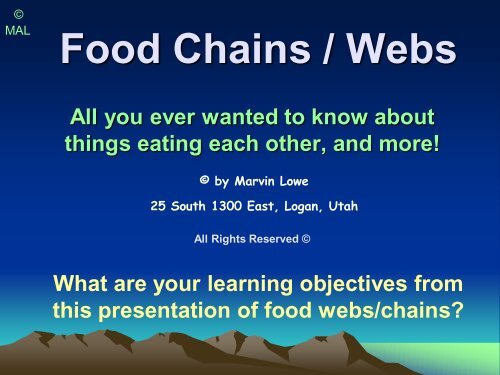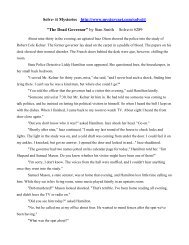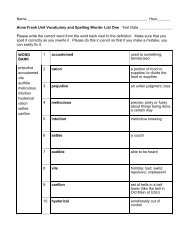Food Web
Food Web
Food Web
Create successful ePaper yourself
Turn your PDF publications into a flip-book with our unique Google optimized e-Paper software.
©<br />
MAL<br />
<strong>Food</strong> Chains / <strong>Web</strong>s<br />
All you ever wanted to know about<br />
things eating each other, and more!<br />
© by Marvin Lowe<br />
25 South 1300 East, Logan, Utah<br />
All Rights Reserved ©<br />
What are your learning objectives from<br />
this presentation of food webs/chains
©<br />
MAL<br />
<strong>Food</strong> <strong>Web</strong>s/Chains<br />
Learning Objectives<br />
Categorize and identify relationships between organisms<br />
(i.e., producer/consumer/decomposer, Trophic Levels,<br />
predator/prey, symbiosis – mutualism / parasitism /<br />
commensalism) and provide examples of each.<br />
Use models to trace the flow of energy and nutrients in food<br />
chains and food webs.<br />
List the five (5) rules you should follow when interpreting<br />
and organizing a food web.<br />
Construct the energy pyramid for a given food web starting<br />
with a specific amount of energy measured in calories at<br />
any particular level of the food web.<br />
List and describe five (5) primary resources that organisms<br />
compete for in an ecosystem.
©<br />
MAL<br />
Terms to Know<br />
• Autotroph<br />
• Calories<br />
• Carnivore<br />
• Chemotroph<br />
• Commensalism<br />
• Competition<br />
• Consumer<br />
• Copavore<br />
• Crowding<br />
• Decomposer<br />
• Ecosystem<br />
• Energy Pyramid<br />
• Environment<br />
• <strong>Food</strong> Chain<br />
• <strong>Food</strong> <strong>Web</strong><br />
• Fructivore<br />
• Habitat<br />
• Hemovore<br />
• Herbivore<br />
• Heterotrophic<br />
• Host<br />
• Mate<br />
• Mutualism<br />
• Niche<br />
• Omnivore<br />
• Organism<br />
• Parasitism<br />
• Predator<br />
• Predation<br />
• Prey<br />
• Primary Consumer<br />
• Producer<br />
• Scavenger<br />
• Secondary Consumer<br />
• Shelter<br />
• Stress<br />
• Symbiosis<br />
• Territory<br />
• Tertiary Consumer
©<br />
MAL<br />
1<br />
<strong>Food</strong> Chains<br />
• A food chain is a<br />
simple way to look at<br />
how matter and<br />
energy flow through a<br />
specific part of an<br />
ecosystem.<br />
• Organisms don’t<br />
generally eat only one<br />
thing, so the picture is<br />
never this simple.
©<br />
MAL<br />
2<br />
<strong>Food</strong> <strong>Web</strong>s<br />
• A <strong>Food</strong> <strong>Web</strong> is a model<br />
used to represent energy<br />
and matter flowing<br />
through an ecosystem.<br />
• <strong>Food</strong> webs look<br />
complicated because<br />
they are complicated.<br />
Real life is even worse.<br />
• What is missing from this<br />
food web<br />
• Phytoplankton Zooplankton<br />
Phytoplankton
©<br />
MAL<br />
3<br />
<strong>Food</strong> <strong>Web</strong> Rules<br />
1. List all the organisms you’re studying.<br />
2. Answer the question for each organism:<br />
“What eats what”<br />
3. Arrange the organisms in a logical manner,<br />
with the top predators (Tertiary Consumers)<br />
at the top of your chart, and the Producers<br />
at the bottom of your chart.<br />
4. Link the organisms together using arrows that<br />
show the direction in which the ENERGY and<br />
Matter flow.<br />
5. Link the Decomposers to EVERYTHING!
©<br />
MAL<br />
4<br />
Producers, Consumers, and<br />
Decomposers<br />
• A producer uses an energy source (usually<br />
sunlight) to organize food out of raw materials.<br />
(Autotroph)<br />
• A consumer is an organism that can’t make it’s<br />
own food (so they eat producers or other<br />
consumers or both). (Chemotroph)<br />
• A decomposer is an organism that breaks dead<br />
organisms down into simple materials again—<br />
(Nature’s recycling system).
©<br />
MAL<br />
5<br />
Consumer Feeding Levels<br />
• A Primary<br />
Consumer eats<br />
Producers.<br />
• Primary<br />
Consumers are<br />
Herbivores and/or<br />
Fructivore.
©<br />
MAL<br />
6<br />
Consumer Feeding Levels<br />
• A Secondary Consumer<br />
eats Primary<br />
Consumers.<br />
• Secondary Consumers<br />
are Carnivores.
©<br />
MAL<br />
7<br />
Consumer Feeding Levels<br />
• A Tertiary Consumer<br />
(Third Level) eats<br />
organisms that eat other<br />
organisms that eat<br />
producers.<br />
• Some organisms can be<br />
First, Second, and Third<br />
Level Consumers.<br />
(Heterotrophic)<br />
• What level of consumer<br />
are people
©<br />
MAL<br />
8<br />
The Energy Pyramid<br />
• We talked in class about how you have<br />
less energy as you move from Producers<br />
to Primary Consumers, even less as you<br />
go from Primary Consumers to Secondary<br />
Consumers, and so on.<br />
• At every level, energy is used up by<br />
organisms and lost to the environment in<br />
the form of heat energy.<br />
• How much energy moves from one level to<br />
the next
©<br />
MAL<br />
9<br />
Primary<br />
Consumers<br />
Producers<br />
Tertiary<br />
Consumer<br />
(10 kcal) (0.1%)<br />
Secondary<br />
Consumers<br />
(100 kcal) (1%)<br />
(1,000 kcal) (10%)<br />
(10,000 kcal) (100%)<br />
The Energy Pyramid<br />
• Only Ten Percent!<br />
(10%)<br />
• If you have 10,000<br />
kilocalories available<br />
at the Producer level,<br />
you have 1,000<br />
kilocalories available<br />
at the Primary<br />
Consumer Level, 100<br />
kilocalories at the<br />
Secondary Consumer<br />
level, and 10<br />
kilocalories left at the<br />
tertiary Consumer<br />
level.
©<br />
MAL<br />
10<br />
The Energy Pyramid<br />
Decreasing<br />
number of<br />
organisms<br />
Decreasing<br />
Energy<br />
Increasing<br />
number of<br />
organisms<br />
Increasing<br />
Energy<br />
This is a direct relationship
©<br />
MAL<br />
11<br />
Resources<br />
• Energy is one resource organisms need to<br />
live. They compete to get energy (food).<br />
• Organisms also compete for territory,<br />
mates, shelter, and water.<br />
• A niche is an organism’s place in the<br />
ecosystem. It’s basically a way to make<br />
sure that two organisms don’t have to fight<br />
too hard for the same food resource.
©<br />
MAL<br />
12<br />
Species Interactions<br />
Organisms interact in Five general ways:<br />
• Symbiotic Relationships (Symbiosis)<br />
Mutualism/Parasitism/Commensalism<br />
• Predation<br />
• Competition<br />
• Crowding<br />
• Stress
©<br />
MAL<br />
13<br />
Mutualism (+/+)<br />
(Symbiosis)<br />
• In Mutualism, both<br />
organisms involved<br />
benefit from the<br />
interaction.<br />
• Turkey Vultures find<br />
the meat, King<br />
Vultures rip open the<br />
carcass, and<br />
everyone has a feast.
©<br />
MAL<br />
14<br />
Parasitism (+/-)<br />
(Symbiosis)<br />
• Parasitism is a special<br />
type of Predation.<br />
• Parasites live on or in a<br />
host organism and steal<br />
resources from that<br />
organism.<br />
• It isn’t usually wise for a<br />
parasite to kill it’s host.
©<br />
MAL<br />
15<br />
Commensalism (+/0)<br />
(Symbiosis)<br />
• In commensalism one of<br />
the organism benefits<br />
and the other neither<br />
benefits or is harmed by<br />
the relationship.
©<br />
MAL<br />
16<br />
Predation (+/-)<br />
NOT SYMBIOSIS<br />
• One species benefits<br />
• The other is hunted, killed and<br />
eaten.<br />
• Predation is beneficial to prey<br />
species because it removes the<br />
old, sick, weak, members of the<br />
population. The fact that<br />
sometimes the very young<br />
members of the population are<br />
removed is not a benefit.<br />
• Even though it can benefit the<br />
prey population, I still doubt this<br />
Zebra really wanted to be eaten.
©<br />
MAL<br />
17<br />
Competition (-/-)<br />
NOT SYMBIOSIS<br />
• Competition is not a form of<br />
symbiosis but has a (-/-)<br />
relationship between the<br />
organisms involved.<br />
• Competition is when two or more<br />
organisms are competing for the<br />
same resource.<br />
• This is avoided by specializing into<br />
different niches.<br />
• Cooper’s Hawks hunt birds, Red-<br />
Tailed Hawks hunt rodents while<br />
living in the same eco-system.
©<br />
MAL<br />
18<br />
Competition Within Species<br />
Members of the same species can compete<br />
for the same resources such as territory,<br />
mates, shelter, water, and food.<br />
Any kind of competition either inter or intra<br />
species will cause the elimination of the old,<br />
sick, weak, and not a benefit, sometimes the<br />
very young members of some populations of<br />
organisms.
©<br />
MAL<br />
23<br />
Terms to Know<br />
• Calories<br />
• Carnivore<br />
• Commensalism<br />
• Competition<br />
• Coprovore<br />
• Decomposer<br />
• Ecosystem<br />
• Energy Pyramid<br />
• Environment<br />
• <strong>Food</strong> Chain<br />
• <strong>Food</strong> <strong>Web</strong><br />
• Fructivore<br />
• Habitat<br />
• Hemovore<br />
• Herbivore<br />
• Mutualism<br />
• Mate<br />
• Niche<br />
• Organism<br />
• Omnivore<br />
• Parasitism<br />
• Predator<br />
• Predation<br />
• Prey<br />
• Primary Consumer<br />
• Producer<br />
• Scavenger<br />
• Secondary Consumer<br />
• Symbiosis<br />
• Territory<br />
• Tertiary Consumer
©<br />
MAL<br />
24<br />
<strong>Food</strong> <strong>Web</strong>/<strong>Food</strong> Chain objectives<br />
Review<br />
● Categorize the relationships between organisms<br />
(i.e., producer/consumer/decomposer, trophic levels,<br />
predator/prey, symbiosis – mutualism / parasitism /<br />
commensalism) and provide examples of each.<br />
● Use models to trace the flow of energy in food chains<br />
and food webs.<br />
● List the rules you should follow when interpreting<br />
and organizing a food web.<br />
● Construct the energy pyramid for a given food web<br />
starting with a specific amount of energy measured<br />
in calories at any particular level of the food web.<br />
● List and describe four (4) primary resources that<br />
organisms compete for in an ecosystem.
©<br />
MAL<br />
25<br />
Glossary<br />
A - C D - E F - G H - L M - O P - R S - Z<br />
Select the above letter category in<br />
which the word you are looking for<br />
would be found.
©<br />
MAL<br />
26<br />
Glossary (A – C)<br />
Autotrophic – Any organism that makes its own food using<br />
sunlight as the energy source. (algae, plants and some bacteria)<br />
Calories – A metric unit used to measure the energy needed to<br />
raise the temperature of one gram of water by one degree<br />
Celsius. The energy gained by respiration of food is measured<br />
in calories.<br />
Carnivore – An animal that eats only other animals. Lions are<br />
carnivores.<br />
Chemotrophic – Any organism that can not produce its own<br />
food but must eat producers or other consumers.<br />
Commensalism – A symbiotic relationship between two<br />
organisms of different species in which one derives some<br />
benefit while the other is unaffected. A birds nest in a tree is<br />
an example of commensalism.
©<br />
MAL<br />
27<br />
Glossary (C – C)<br />
Competition – The simultaneous demand by two or more<br />
organisms for limited environmental recourses. Mice and<br />
grasshoppers are in competition for grass to eat.<br />
Consumer – Any organism that must eat producers or other<br />
consumers.<br />
Coprovore – An animal that eats feces of animals. Dogs and<br />
dung beetles are coprovores.<br />
Crowding – The number and closeness of all of the various<br />
organisms in an ecosystem.
©<br />
MAL<br />
28<br />
Glossary (D – E)<br />
Decomposer – An organism that breaks down large chemical<br />
molecules from dead organisms into small chemical molecules<br />
and returns important materials to the soil and water. Fungi,<br />
earth worms, and some bacteria are decomposers.<br />
Ecosystem – All of the living and non living things that interact<br />
in a specific area. The Cache Valley wet lands might be<br />
considered an ecosystem.<br />
Energy Pyramid – A diagram that show the amount of energy<br />
that moves from one feeding level to another in a food chain.<br />
The rule of thumb in an energy pyramid is that 90% of the<br />
incoming energy is used for life function leaving 10% that is<br />
passed on to the next level of the food chain.<br />
Environment – A combination of the abiotic and biotic factors<br />
and there effect on each other in an ecosystem.
©<br />
MAL<br />
29<br />
Glossary (F – G)<br />
<strong>Food</strong> Chain – A series of events in which one organism eats<br />
another. Producers are always the first thing in a food<br />
chain.<br />
<strong>Food</strong> <strong>Web</strong> – The pattern of overlapping food chains in an<br />
ecosystem. That food web of the organisms in the Cache<br />
Valley wet lands.<br />
Fructivore – An organism that eats mostly fruit. Fruit Bats,<br />
and some monkeys are fructivores.
©<br />
MAL<br />
30<br />
Glossary (H – L)<br />
Habitat – The place where an organism lives and provides the<br />
things the organism needs. The place an organism lives is its<br />
habitat.<br />
Hemovore – An organism that eats blood predominantly.<br />
Mesquites are hemovores.<br />
Herbivore – An organism that eats predominantly plant<br />
material. Deer cows and horses are all herbivores.<br />
Heterotrophic – Consumers that can eat at more than one<br />
trophic level.
©<br />
MAL<br />
31<br />
Glossary (M – O)<br />
Mate – The sexual partner of an organism. The mother of<br />
those puppies is that dogs mate.<br />
Mutualism – A type of symbiosis in which both organisms<br />
benefit from living with each other. The relationship between<br />
the long eared bat and the saguaro cactus is mutualism.<br />
Niche – An organisms role in an ecosystem, how it makes its<br />
living. Each organism fills a specific niche.<br />
Omnivore – Can eat almost any kind of food. Humans and<br />
bears are omnivores.<br />
Organism – A living thing. All organisms need to eat food.
©<br />
MAL<br />
32<br />
Glossary (P - R)<br />
Parasitism – A relationship in which one organism lives in or<br />
on another organism and harms it. The relationship between<br />
mosquitoes and human is parasitism.<br />
Predator – A carnivore that hunts and kills other animals for<br />
food and has adaptations that help it capture the animals it<br />
preys upon. One of the predators of a zebra is a lion.<br />
Predation – The act of being a predator. Barn owls practice<br />
predation of voles.<br />
Prey – An animal that a predator feeds upon. Grasshoppers<br />
are prey of snakes.<br />
Primary consumer – An organism that eats producers<br />
(autotrophs). Rabbits are primary consumers.<br />
Producer – An organism that can make its own food. Plants<br />
and some bacteria are producers.
©<br />
MAL<br />
33<br />
Glossary (S – Z)<br />
Scavenger – A carnivore that feeds on the bodies of dead or<br />
nearly dead organisms. Vultures are scavengers.<br />
Secondary consumer – An organism that eats primary<br />
consumers. When a snake eats a cricket it is a secondary<br />
consumer.<br />
Symbiosis – A close relationship between two organisms in<br />
which at least one organism benefits. There are three type of<br />
symbiosis; mutualism, parasitism, and commensalism.<br />
Territory – An area that is occupied and defended by an<br />
animal or group of animals. A wolf marks its territory by<br />
urinating around the outer edge of the territory.<br />
Tertiary consumer – An organism that eats secondary<br />
consumers. When a hawk eats a small bird that has eaten a<br />
grasshopper it is a tertiary consumer.
©<br />
MAL<br />
34<br />
Terms to Know<br />
• Calories<br />
• Carnivore<br />
• Commensalism<br />
• Competition<br />
• Consumer<br />
• Coprovore<br />
• Decomposer<br />
• Ecosystem<br />
• Energy Pyramid<br />
• Environment<br />
• <strong>Food</strong> Chain<br />
• <strong>Food</strong> <strong>Web</strong><br />
• Fructivore<br />
• Habitat<br />
• Hemovore<br />
• Herbivore<br />
• Mate<br />
• Mutualism<br />
• Niche<br />
• Omnivore<br />
• Organism<br />
• Parasitism<br />
• Predator<br />
• Predation<br />
• Prey<br />
• Primary Consumer<br />
• Producer<br />
• Scavenger<br />
• Secondary Consumer<br />
• Symbiosis<br />
• Territory<br />
• Tertiary Consumer
















